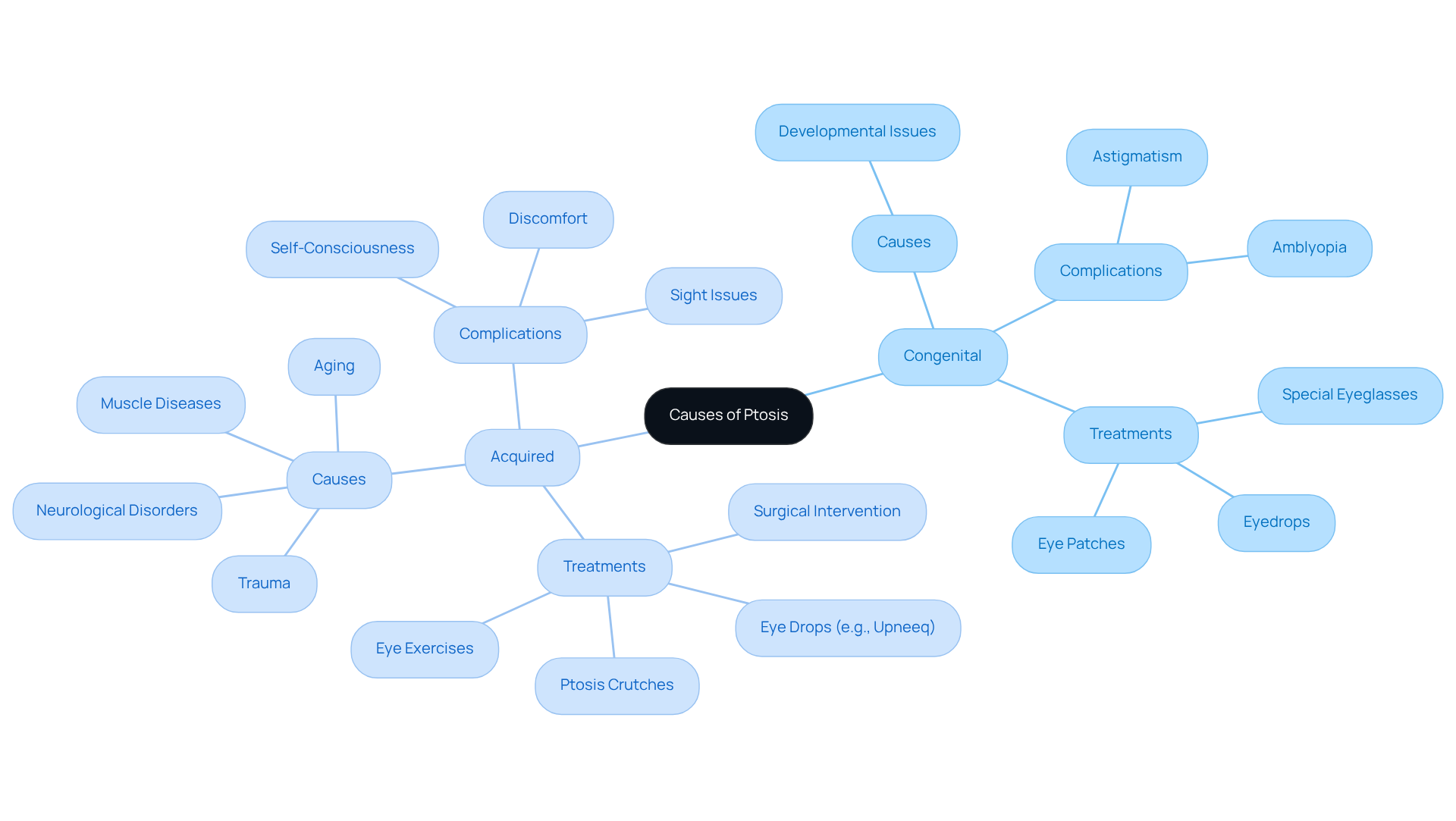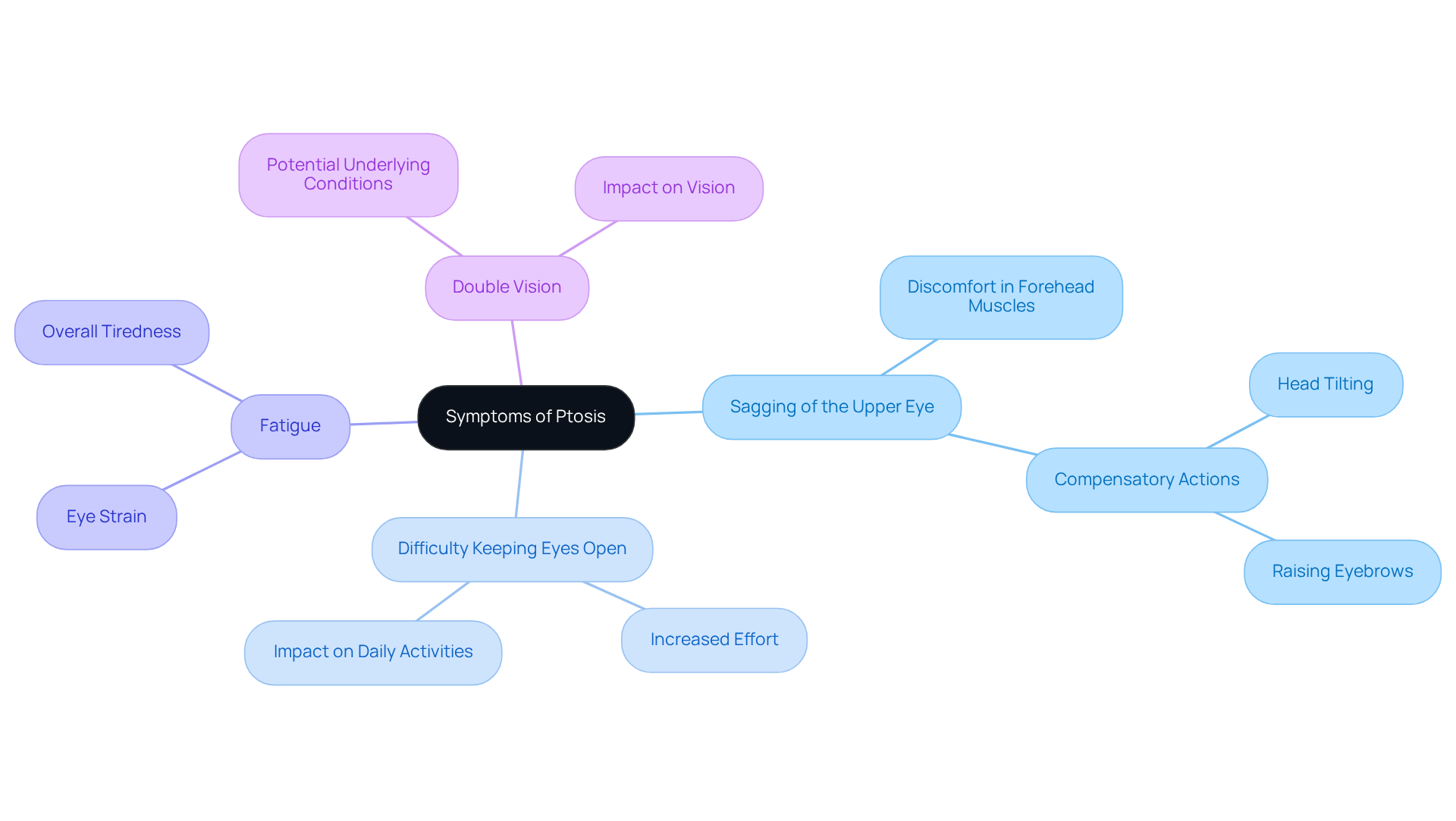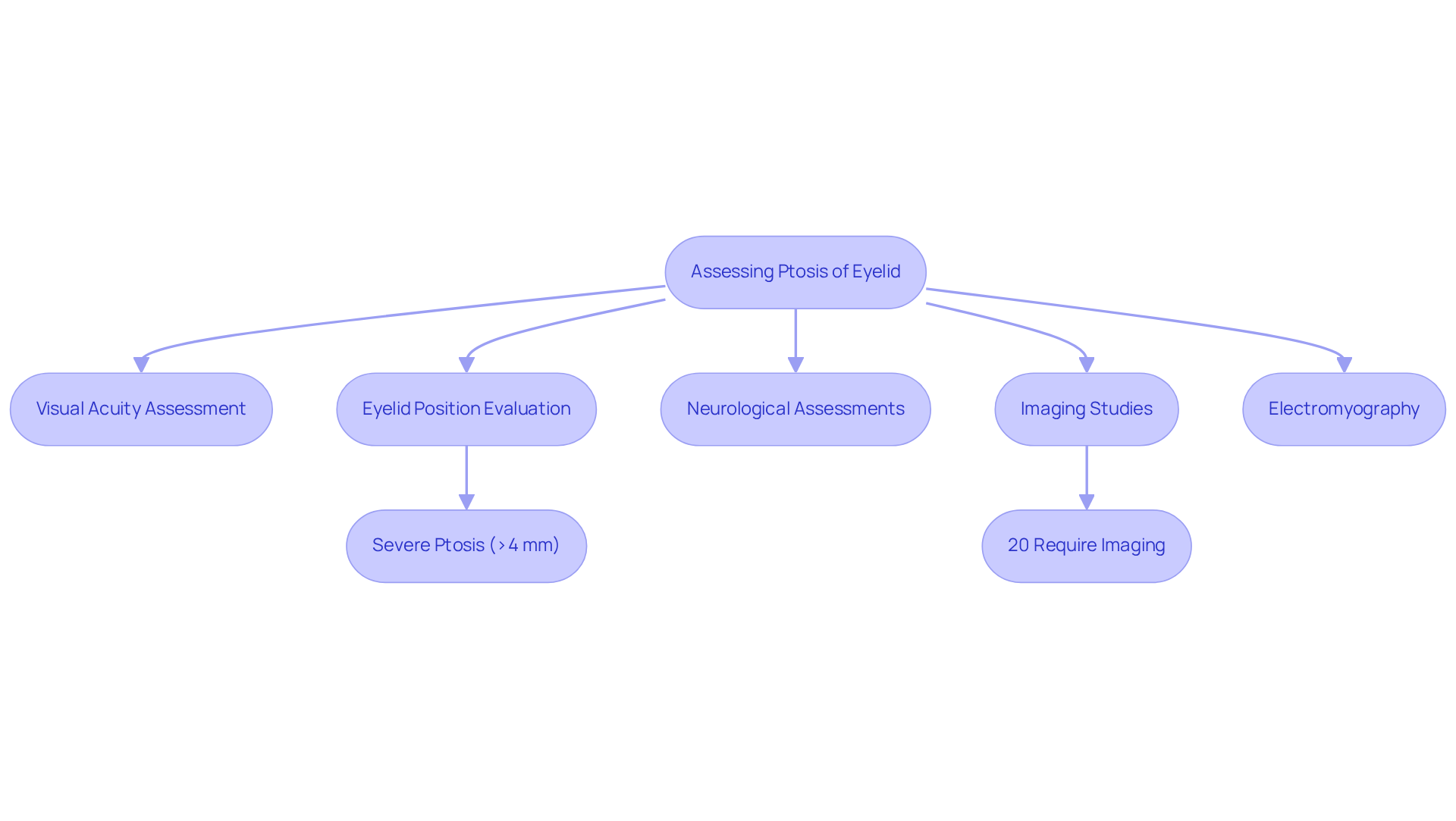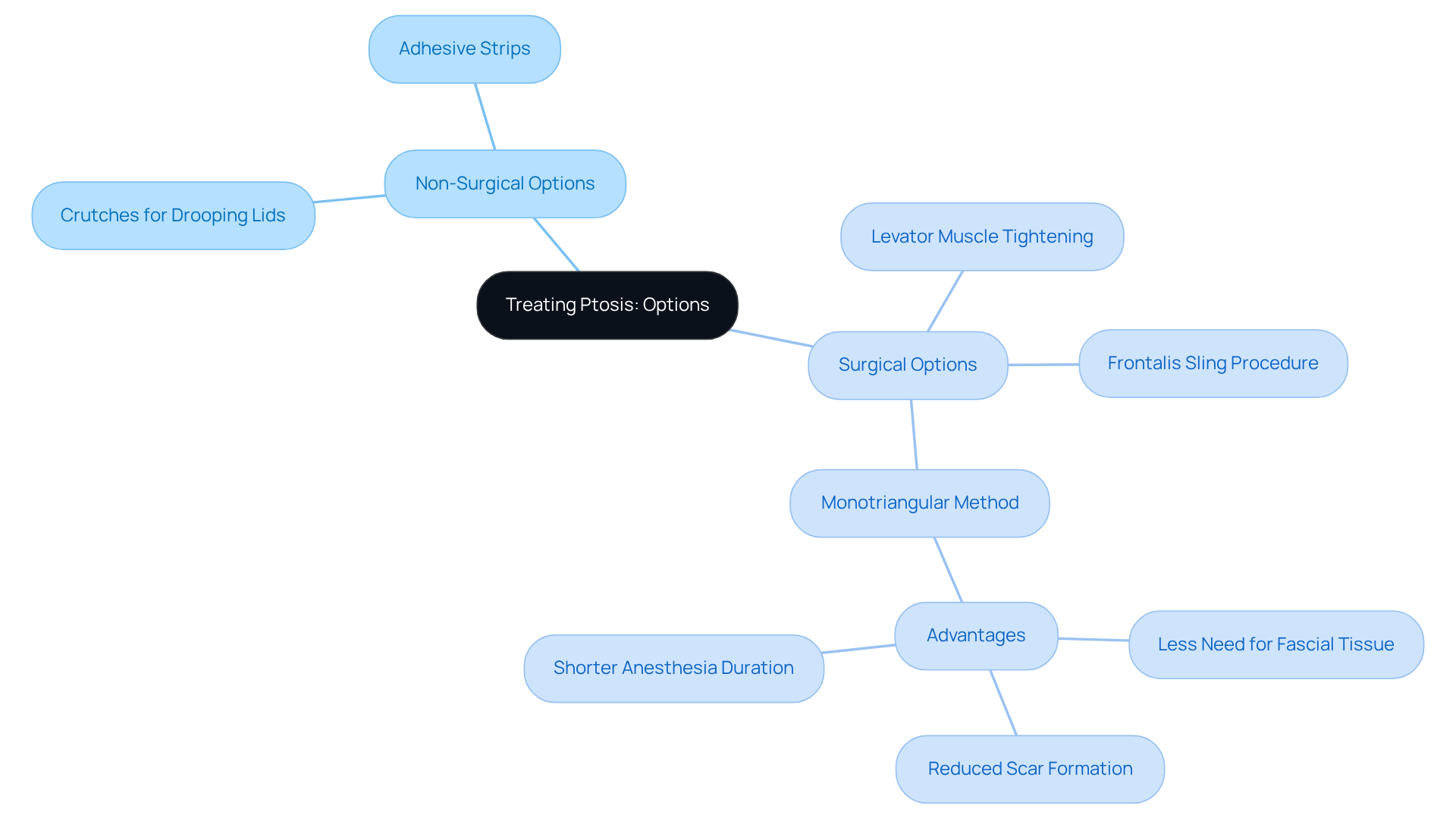Posted by: Northwest Eye in General on August 13, 2025
Overview
Ptosis of the eyelid, often referred to as droopy eyelids, can understandably be a concern for many. This condition is primarily caused by muscle weakness, nerve damage, and age-related changes, which can significantly affect both vision and aesthetics. We understand that learning about these causes can be overwhelming, but it’s important to know that you are not alone in this journey.
The article highlights the various treatments available, including surgical options like functional blepharoplasty and non-surgical alternatives. These options aim to effectively manage the functional and cosmetic issues associated with ptosis. We want you to feel reassured that there are paths to improve both your vision and appearance.
We are here to help you through this process, ensuring you have the information you need to make informed decisions. Remember, it’s common to feel uncertain about these options, but understanding them can help alleviate some of that anxiety. Together, we can explore the best solutions tailored to your needs.
Introduction
Ptosis of the eyelid, often referred to as droopy eyelids, is a condition that affects many people, especially as they age. We understand that this condition can lead to aesthetic concerns, making individuals feel tired or uneven. More importantly, it can also cause serious functional impairments, such as obstructed vision.
By understanding the multifaceted nature of ptosis—including its causes, symptoms, and treatment options—you can feel empowered to seek timely medical intervention. It’s common to feel overwhelmed when faced with the challenges of ptosis, but effective treatments can restore both your sight and confidence.
We are here to help you through this process.
Define Ptosis: Understanding Droopy Eyelids
, commonly known as , is an ailment that can understandably cause concern. The sagging of one or both eyelids, known as ptosis of eyelid, can arise from several factors, including muscle weakness, nerve damage, and age-related changes. We understand that the occurrence of ptosis of eyelid rises with age; research shows that around face this issue, and rates can escalate to 5.8% among individuals aged 65 to 69 years.
It’s common to feel that ptosis of eyelid may hinder your sight, resulting in considerable functional difficulties. Many patients find their range of sight limited, which can and overall quality of life. Comprehending ptosis of eyelid is —often making individuals appear ‘sleepy’ or uneven. Therefore, it requires to tackle both functional and aesthetic issues caused by ptosis of eyelid.
At Northwest Eye, we are here to help you through this process. provides surgical alternatives such as and eyelid lift to effectively restore vision and . Recovery from these procedures typically involves some bruising and swelling, and we advise patients to rest at home for a few days.
Awareness and proactive management of this prevalent issue are essential. Ptosis of eyelid may correlate with systemic disorders such as diabetes and hypertension, underscoring the importance of . Remember, you are not alone in this; we are here to support you every step of the way.

Explore Causes of Ptosis: Congenital vs. Acquired
Ptosis can be classified into two main categories: congenital and acquired. We understand that , which is present at birth, often results from developmental issues with the levator muscle responsible for lifting the eyelid. This condition can lead to significant complications, such as amblyopia and astigmatism, if not addressed early. Children with congenital drooping of the eyelid may require interventions like eye patches, special eyeglasses, or eyedrops to support the weaker eye.
develops later in life and can arise from factors such as aging, trauma, neurological disorders, or muscle diseases. It’s common to feel concerned about involutional eyelid droop, a prevalent type of acquired eyelid droop that primarily affects older adults when the levator muscle stretches and separates from the eyelid. Dr. M. Ronan Conlon highlights that “the effects of developed eyelid droop can be both aesthetic and practical, as it may lead to sight issues, discomfort, and self-awareness regarding one’s looks.”
Recent research emphasizes the for both congenital and acquired drooping of the eyelids. Understanding these causes is essential for tailoring effective treatment strategies and managing patient expectations. For adults, addressing acquired ptosis is crucial to preserving quality of life and sight as they age. Identifying the symptoms and pursuing prompt medical care can avert additional complications, such as obstructed sight, eye strain, and cosmetic issues, ensuring improved results.
If your eyelid suddenly droops or you experience symptoms like , headache, or weakness, it is important to see a doctor promptly. Most patients recover from eyelid surgery within a few weeks, but complete healing may require up to a few months. include crutches for drooping eyes (eyeglass attachments), eye drops such as Upneeq, and eye exercises, which can offer further context on treatment alternatives. We are here to help you through this process, ensuring you receive the care and support you need.

Identify Symptoms of Ptosis: Recognizing the Signs
The most prominent is the noticeable , which can range from mild to severe. We understand that this can be concerning. Patients often report additional symptoms such as:
- Difficulty keeping their eyes open
- Fatigue
- In some instances,
It’s common to feel as individuals try to adjust for the of the eyelid. is crucial; can significantly enhance both . emphasize the importance of being aware of these symptoms, as they can indicate underlying issues that may require medical attention. We are here to help you through this process. Patient testimonials often highlight how this condition affects daily activities, reinforcing the need for awareness and .

Evaluate Ptosis: Diagnostic Tests and Assessments
Assessing can be concerning, and we want you to feel supported throughout this process. A thorough is essential and includes several key evaluations. Visual acuity assessments help us understand how eyelash drooping may affect your vision. We also evaluate to gauge the extent of ptosis of eyelid, noting that severe instances may show a sag surpassing 4 mm. Normal levator function (LF) is recorded as greater than 10 mm, which is crucial for our understanding of ptosis of eyelid.
We understand that neurological assessments can feel daunting, but they are vital for detecting any underlying nerve dysfunction, especially in cases of . Conditions such as Horner’s syndrome or oculomotor nerve injury may be involved. Alongside these evaluations, imaging studies are often necessary. In fact, about 20% of patients with require these tests to rule out structural abnormalities. Electromyography may also be employed to assess , particularly in suspected myogenic causes like myasthenia gravis.
This comprehensive approach ensures that we consider all possible factors contributing to ptosis of eyelid, allowing us to create a tailored to your individual needs. Case studies highlight the importance of accurate diagnostic assessments. For instance, one patient with suspected myogenic drooping underwent a series of tests, including a positive edrophonium test, which indicated . This led to a targeted treatment strategy that significantly improved eyelid elevation.
We want you to know that such for achieving in managing ptosis of eyelid. Remember, we are here to help you through this journey, ensuring you receive the care and support you deserve.

Treat Ptosis: Surgical and Non-Surgical Options
Treatment for can feel overwhelming, but there are both surgical and available to help you. Non-surgical techniques, such as crutches for drooping lids or adhesive strips, can provide short-term relief by gently raising the lid. However, if you’re seeking lasting results, may be necessary.
or employing a frontalis sling procedure. These approaches are tailored to the severity and underlying cause of your ptosis of eyelid. Recent advancements in eyelid droop surgery have introduced . This innovative approach offers benefits such as a reduced need for fascial tissue, less scar formation around the eyes, and shorter anesthesia duration.
It’s reassuring to know that . Studies indicate that 80-85% of patients achieve satisfactory correction after their first procedure. However, it’s also important to understand that around 15-20% of patients may require additional surgeries due to issues like incorrect positioning of the eyelids.
We understand that . This decision should be guided by a thorough evaluation and a between you and your ophthalmic surgeon. This ensures that your individual needs and expectations are fully addressed. As Dr. Jeffrey A. Nerad emphasizes, and associated conditions is crucial for determining the most effective treatment approach. We are here to help you through this process and support you every step of the way.

Conclusion
Understanding ptosis of the eyelid is crucial for addressing both its functional and aesthetic implications. We recognize that this condition, characterized by the drooping of one or both eyelids, can stem from various causes, including muscle weakness, nerve damage, and age-related changes. It’s common to feel concerned about how ptosis impacts not only vision but also one’s appearance and self-esteem.
Key insights reveal the distinction between congenital and acquired ptosis, highlighting the importance of early diagnosis and tailored treatment strategies. Symptoms such as difficulty keeping the eyes open, fatigue, and discomfort can significantly affect daily life. We understand that comprehensive diagnostic evaluations are vital in determining the underlying causes and guiding appropriate interventions. Treatment options range from non-surgical approaches to surgical procedures, ensuring that individuals can find a solution that meets their needs.
Ultimately, awareness and proactive management of ptosis of the eyelid can lead to improved quality of life and enhanced visual function. If you are experiencing symptoms, we encourage you to seek timely medical advice to explore available treatments. By understanding this condition and its implications, you can take informed steps toward regaining your confidence and sight. Remember, we are here to help you through this process.
Frequently Asked Questions
What is ptosis of the eyelid?
Ptosis of the eyelid, commonly referred to as droopy eyelids, is a condition characterized by the sagging of one or both eyelids, which can result from factors such as muscle weakness, nerve damage, or age-related changes.
How common is ptosis of the eyelid?
The occurrence of ptosis increases with age, affecting around 11.5% of adults, with rates rising to 5.8% among individuals aged 65 to 69 years.
What impact does ptosis have on vision and daily life?
Ptosis can limit the range of sight, potentially hindering daily activities and overall quality of life, as it may cause individuals to appear ‘sleepy’ or uneven.
What surgical options are available for treating ptosis?
Surgical alternatives for treating ptosis include functional blepharoplasty and eyelid lift, which aim to restore vision and enhance appearance.
What is the recovery process like after eyelid surgery?
Recovery from eyelid surgery typically involves some bruising and swelling, and patients are advised to rest at home for a few days.
What are the two main types of ptosis?
The two main types of ptosis are congenital, which is present at birth, and acquired, which develops later in life due to factors like aging, trauma, or neurological disorders.
What complications can arise from congenital ptosis?
Congenital ptosis can lead to complications such as amblyopia (lazy eye) and astigmatism if not addressed early.
What are common causes of acquired ptosis?
Acquired ptosis can result from aging, trauma, neurological disorders, or muscle diseases, with involutional eyelid droop being a prevalent type affecting older adults.
Why is early diagnosis and treatment important for ptosis?
Early diagnosis and treatment are crucial to prevent complications such as obstructed sight, eye strain, and cosmetic issues, ultimately preserving quality of life and sight as individuals age.
What non-surgical alternatives exist for treating sagging eyelids?
Non-surgical alternatives include eyeglass attachments (crutches for drooping eyes), eye drops like Upneeq, and eye exercises, which can help address sagging eyelids.






